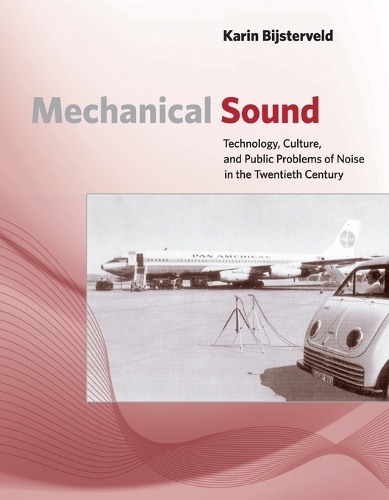
Mechanical Sound: Technology, Culture, and Public Problems of Noise in theTwentieth Century
(Paperback)
Publishing Details
Mechanical Sound: Technology, Culture, and Public Problems of Noise in theTwentieth Century
By (Author) Karin Bijsterveld
MIT Press Ltd
MIT Press
10th February 2017
United States
Classifications
Professional and Scholarly
Non Fiction
Wave mechanics (vibration and acoustics)
620.2
Physical Properties
Paperback
362
Width 178mm, Height 229mm, Spine 16mm
Description
Tracing efforts to control unwanted sound-the noise of industry, city traffic, gramophones and radios, and aircraft-from the late nineteenth to the late twentieth century.Since the late nineteenth century, the sounds of technology have been the subject of complaints, regulation, and legislation. By the early 1900s, antinoise leagues in Western Europe and North America had formed to fight noise from factories, steam trains, automobiles, and gramophones, with campaigns featuring conferences, exhibitions, and "silence weeks." And, as Karin Bijsterveld points out in Mechanical Sound, public discussion of noise has never died down and continues today. In this book, Bijsterveld examines the persistence of noise on the public agenda, looking at four episodes of noise and the public response to it in Europe and the United States between 1875 and 1975- industrial noise, traffic noise, noise from neighborhood radios and gramophones, and aircraft noise. She also looks at a twentieth-century counterpoint to complaints about noise- the celebration of mechanical sound in avant-garde music composed between the two world wars. Bijsterveld argues that the rise of noise from new technology combined with overlapping noise regulations created what she calls a "paradox of control." Experts and politicians promised to control some noise, but left other noise problems up to citizens. Aircraft noise, for example, measured in formulas understandable only by specialists, was subject to public regulation; the sounds of noisy neighborhoods were the responsibility of residents themselves. In addition, Bijsterveld notes, the spatial character of anti-noise interventions that impose zones and draw maps, despite the ability of sound to cross borders and boundaries, has helped keep noise a public problem. We have tried to create islands of silence, she writes, yet we have left a sea of sounds to be fiercely discussed. Tracing efforts to control unwanted sound-the noise of industry, city traffic, gramophones and radios, and aircraft-from the late nineteenth to the late twentieth century.Since the late nineteenth century, the sounds of technology have been the subject of complaints, regulation, and legislation. By the early 1900s, antinoise leagues in Western Europe and North America had formed to fight noise from factories, steam trains, automobiles, and gramophones, with campaigns featuring conferences, exhibitions, and "silence weeks." And, as Karin Bijsterveld points out in Mechanical Sound, public discussion of noise has never died down and continues today. In this book, Bijsterveld examines the persistence of noise on the public agenda, looking at four episodes of noise and the public response to it in Europe and the United States between 1875 and 1975- industrial noise, traffic noise, noise from neighborhood radios and gramophones, and aircraft noise. She also looks at a twentieth-century counterpoint to complaints about noise- the celebration of mechanical sound in avant-garde music composed between the two world wars. Bijsterveld argues that the rise of noise from new technology combined with overlapping noise regulations created what she calls a "paradox of control." Experts and politicians promised to control some noise, but left other noise problems up to citizens. Aircraft noise, for example, measured in formulas understandable only by specialists, was subject to public regulation; the sounds of noisy neighborhoods were the responsibility of residents themselves. In addition, Bijsterveld notes, the spatial character of anti-noise interventions that impose zones and draw maps, despite the ability of sound to cross borders and boundaries, has helped keep noise a public problem. We have tried to create islands of silence, she writes, yet we have left a sea of sounds to be fiercely discussed.
Reviews
"Complaints about noise are as much a part of modern sound culture as noise itself, and yet we know little of the history of noise. Karin Bijsterveld's "Mechanical Sound" changes all that; it is unprecedented in topic and scope. At once episodic and ambitious, "Mechanical Sound" places noise as one of those 'modern problems' that reformers, legislators, and scholars have tried--unsuccessfully--to control. The book shows how decades of reform, measurement and regulation attempts have resulted in a melange of noise practices and expectations, rather than a fantasyland of peace and harmony. Bijsterveld provides a meaningful alternative to the pieties of noise criticism, whether they come from public health literature or soundscape artists. Because of its range and originality, "Mechanical Sound" will change the way scholars across the disciplines talk about 'noise' and 'silence'."--Jonathan Sterne, Department of Art History and Communication Studies, McGill University, and author of "The
"Karin Bijsterveld is a pioneer in the new field of sound studies. In "Mechanical Sound" she traces the various national approaches toward dealing with the increasing problems posed by the new technological sounds of the late nineteenth and twentieth centuries. Rich in insights from science studies, and with wonderful period photographs including teams of immaculately dressed British citizens judging aircraft noise in the 1950s, this book teases out the nuances of sound and its effects on why we as a society find it so hard to legislate effectively against noise."--Trevor Pinch, Science and Technology Studies, Cornell University
"Karin Bijsterveld's "Mechanical Sound" is an extraordinary achievement, simultaneously an inquiry into our deepest assumptions about the sounds that surround us and an exemplar for future scholars of noise."--Jon Agar, Senior Lecturer in Science and Technology Studies, University College London
"Karin Bijsterveld's
Author Bio
Karin Bijsterveld is Professor of Science, Technology, and Modern Culture at the Department of Science and Technology Studies at Maastricht University, the Netherlands.
